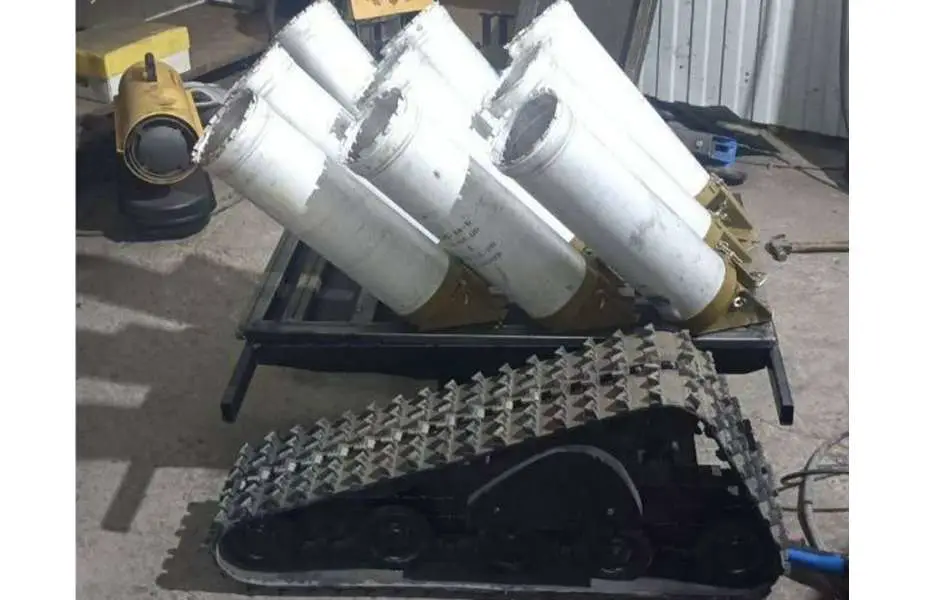Attention was drawn to a remotely operated mining system developed by Russia, showcasing an interesting evolution in Unmanned Ground Vehicle (UGV) technology and an innovative approach. This unmanned vehicle is equipped with PKM-1 mining kits and K-cassettes, tools designed for remote mine deployment. The relatively modest cost of this system is estimated at $3,855.
Follow Army Recognition on Google News at this link

This Russian UGV is equipped with PKM-1 mining kits and K-cassettes, tools designed for remote mine deployment. (Picture source: Open Source Information)
The PKM-1 is a mining kit that enables the rapid deployment of anti-personnel or anti-vehicle mines. Its incorporation into a UGV demonstrates a desire to innovate in the way explosive obstacles are laid without directly exposing soldiers to danger.
The PKM-1 is a portable mining system designed to provide combined infantry and armored units with a rapid and efficient capability to deploy mines, both anti-personnel and anti-tank, either in advance or directly on the front line. This kit is distinguished by its simplicity, aiming to enhance the tactical options available to these units by allowing for the preemptive or combat installation of minefields.
Comprising a primitive metal base with a 45-degree angled launcher equipped with an electrical contact, the PKM-1 system uses powder charges to project mines to a distance of about 30 to 35 meters. It includes a PM-4 demolition device, two lengths of cable of 50 meters each, and a bag, with a total weight of 2.6 kilograms. This base allows for the attachment of containers loaded with various mines, whether anti-personnel (AP) or anti-tank (AT), which are then ejected through an electrical signal triggering the powder charge.
Mines can be launched in different configurations to create minefields tailored to various tactical needs. For example, anti-personnel PFM mines can be dispersed in a way that offers a 30 to 50% probability of hitting, while anti-personnel POM mines, equipped with cables, provide up to a 70% chance of hitting. Anti-tank mines, on the other hand, are projected to a distance of 100 meters, forming an elliptical field that respects the necessary spacing to maximize effectiveness while avoiding overlap in impact zones.
The major interest of the PKM-1 system lies in its ability to rapidly deploy minefields from concealed positions, thus surprising the enemy, at any time and place. This characteristic makes it a valuable tool for managing the movements and advancement of opposing forces, creating temporary or permanent obstacles, channeling or slowing enemy advancement, and protecting strategic positions without the need for direct human presence on the field. In the context of the conflict in Ukraine, the use of such systems can play a crucial role in the dynamics of military operations, offering tactical flexibility and a significant strategic advantage to the forces deploying them.
The K-cassettes, on the other hand, serve to store and launch these mines. Their integration into a remote-controlled system highlights a tactical evolution, allowing for precise mining operations adapted to the rapidly changing battlefronts.
The use of such a vehicle in the context of the conflict in Ukraine illustrates a growing trend toward automation on the battlefield. These UGVs enable offensive or defensive actions while reducing risks for operators. In an operational theater where control of the terrain can change quickly, the ability to rapidly sow mines can prove decisive in disrupting enemy movements or protecting strategic areas.
Furthermore, the relatively low cost of this mining system reveals an economic facet of modern warfare. There is always a cost/destruction ratio, in which drones, in general, excel. As armed forces continuously seek to gain a tactical advantage, the use of unmanned vehicles for remote mining could well become a common practice, potentially influencing future military operations significantly.















